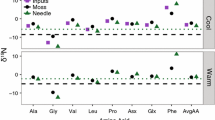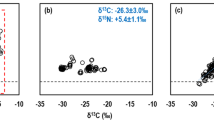Abstract
Heavy water (H 2 18 O) has been used to label DNA of soil microorganisms in stable isotope probing experiments, yet no measurements have been reported for the 18O content of DNA from soil incubated with heavy water. Here we present the first measurements of atom% 18O for DNA extracted from soil incubated with the addition of H 2 18 O. Four experiments were conducted to test how the atom% 18O of DNA, extracted from Ponderosa Pine forest soil incubated with heavy water, was affected by the following variables: (1) time, (2) nutrients, (3) soil moisture, and (4) atom% 18O of added H2O. In the time series experiment, the atom% 18O of DNA increased linearly (R 2 = 0.994, p < 0.01) over the first 72 h of incubation. In the nutrient addition experiment, there was a positive correlation (R 2 = 0.991, p = 0.006) between the log10 of the amount of tryptic soy broth, a complex nutrient broth, added to soil and the log10 of the atom% 18O of DNA. For the experiment where soil moisture was manipulated, the atom% 18O of DNA increased with higher soil moisture until soil moisture reached 30%, above which 18O enrichment of DNA declined as soils became more saturated. When the atom% 18O for H2O added was varied, there was a positive linear relationship between the atom% 18O of the added water and the atom% 18O of the DNA. Results indicate that quantification of 18O incorporated into DNA from H 2 18 O has potential to be used as a proxy for microbial growth in soil.




Similar content being viewed by others

References
Alden L, Demoling F, Baath E (2001) Rapid method of determining factors limiting bacterial growth in soil. Appl Environ Microbiol 67:1830–1838
Baath E (1990) Thymidine incorporation into soil bacteria. Soil Biol Biochem 22:803–810
Chaney SG, Duffy JJ, Boyer PD (1972) Patterns of oxygen interchange between water, substrates and phosphate compounds of Escherichia coli and Bacillus subtilis. J Biol Chem 247:2145–2150
Dijkstra P, Menyailo OV, Schwartz E, Hart SC, Hungate BA (2006) 13C and 15N natural abundance of the soil microbial biomass. Soil Biol Biochem 38:3257–3266
Findlay SEG, Meyer JL, Edwards RT (1984) Measuring bacterial production via rate of incorporation of [3H]thymidine into DNA. J Microbiol Methods 2:57–72
Hoyle FC (2007) Microbial response to the addition of soluble organic substrates. Aust J Soil Res 45:559–567
Kieft TL, Soroker E, Firestone MK (1987) Microbial biomass response to a rapid increase in water potential when dry soil is wetted. Soil Biol Biochem 19:119–126
Iovieno P, Baath E (2008) Effect of drying and rewetting on bacterial growth rates in soil. FEMS Microbiol Ecol 65:400–407
Neufeld JD, Vohra J, Dumont MG, Lueders T, Manefield M, Friedrich MW, Murrell JC (2007) DNA stable-isotope probing. Nature Prot 2:860–866
Orchard VA, Cook FJ (1983) Relationship between soil respiration and soil moisture. Soil Biol Biochem 15:447–453
Paul EA, Clark FE (1996) Soil microbiology and biochemistry, 2nd edn. Academic, San Diego
Pollard PC, Moriarty DJW (1984) Validity of the tritiated thymidine method for estimating bacterial growth rates: measurement of isotope dilution during DNA synthesis. Appl Environ Microbiol 48:1076–1083
Radajewski S, Ineson P, Parkeh NR, Murrell JC (2000) Stable-isotope probing as a tool in microbial ecology. Nature 403:646–649
Richards OC, Boyer PD (1966) 18O labeling of deoxyribonucleic acid during synthesis and stability of the label during replication. J Mol Biol 19:109–119
Schwartz E (2007) Characterization of growing microorganisms in soil by stable isotope probing with H 2 18 O. Appl Environ Microbiol 73:2541–2546
Schwartz E (2009) Analyzing microorganisms in environmental samples using stable isotope probing with H 2 18 O. Cold Spring Harbor Prot. doi:10.1101/pdb.prot5341
Stark JM, Firestone MK (1995) Mechanisms for soil moisture effects on activity of nitrifying bacteria. Appl Environ Microbiol 61:218–221
Tate RL III, Terry RE (1980) Variation in microbial activity in histosols and its relationship to soil moisture. Appl Environ Microbiol 40:313–317
Wardle DA, Parkinson D (1990) Comparison of physiological techniques for estimating the response of the soil microbial biomass to soil moisture. Soil Biol Biochem 22:811–823
Acknowledgments
This work was supported by the Office of Science (BER), US Department of Energy, Grant No. DE-FG02-04ER63883 and the National Science Foundation, Grant No. EF-0747397. We gratefully acknowledge Dave Harris’s IRMS expertise at the UC Davis Stable Isotope Facility, and we thank Rebecca Daly for valuable comments on the manuscript.
Author information
Authors and Affiliations
Corresponding author
Rights and permissions
About this article
Cite this article
Blazewicz, S.J., Schwartz, E. Dynamics of 18O Incorporation from H 2 18O into Soil Microbial DNA. Microb Ecol 61, 911–916 (2011). https://doi.org/10.1007/s00248-011-9826-7
Received:
Accepted:
Published:
Issue Date:
DOI: https://doi.org/10.1007/s00248-011-9826-7



